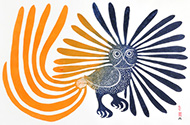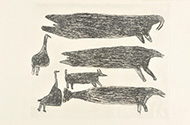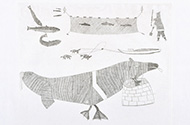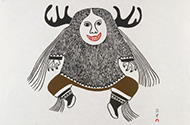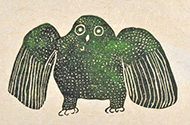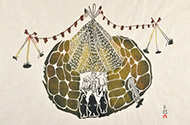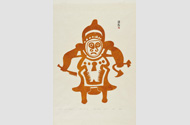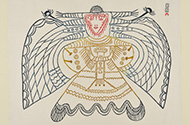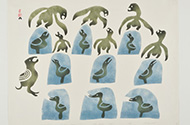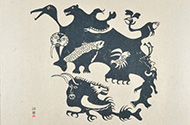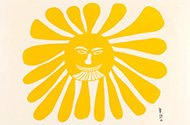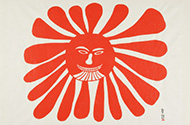1960s Establishing a Base
In 1960 the West Baffin Eskimo Co-operative board hired Terrence Ryan, a graduate of the Ontario College of Art, to be the studio manager and resident arts advisor. In 1960 and 1961 the co-operative produced robust, vibrant collections with a respective total of 65 and 83 different relief and stencil prints each year. In 1961 Ryan encouraged the creation of the first copper-plate engravings and etchings—a more direct technique in which artists drew directly on the copper print plate.
Throughout the decade, Ryan invited many Southern artists into the Cape Dorset studio as temporary guests and advisors to work alongside Inuit printmakers, setting the pattern of exploration, collaboration and invention that continues today.
Many notable women in Cape Dorset emerged as powerful graphic artists, creating the original drawings behind some of the most popular prints — Kenojuak Ashevak, Pitseolak Ashoona, Lucy Qinnuajuak and Napachie Pootoogook, among others. Many talented men also contributed drawings to the studio, including Kiakshuk, Pudlo Pudlat and Parr. For much of the 1960s, the studio’s artists relied on six printmakers who translated their drawings into finished stonecut and stencil prints—Osuitok Ipeelee, Kananginak Pootoogook, Eegyvudluk Pootoogook, Iyola Kingwatsiak, Lukta Qiatsuk and Timothy Ottochie.
For the remainder of the 1960s, the studio built a stable of artists who regularly contributed to the Cape Dorset print program. The printmakers continued to refine and master a variety of techniques—stonecut, stencil and etching—and periodically attempted new ones, such as serigraph in 1964–1965. The studio also attempted a commercial hand-printed fabric enterprise, which eventually tapered off in the late 1960s.
During the decade, the studio released roughly 60 to 90 different prints per year, typically in editions of 50. To accommodate the growing operations, the West Baffin Eskimo Co-operative added several studio buildings and a residence.
This new and unprecedented creative venture — a community-owned print studio in the Arctic — was a source of income and pride for the residents of Cape Dorset, offering an artistic and culturally affirming way of recording old stories, history, myths and legends. The success of Cape Dorset inspired many other Inuit communities across the Arctic to create their own print studio.

